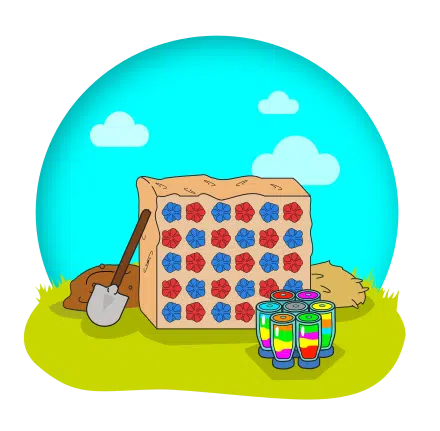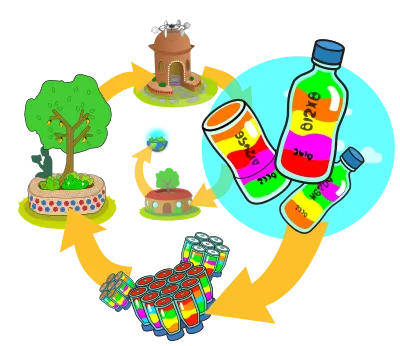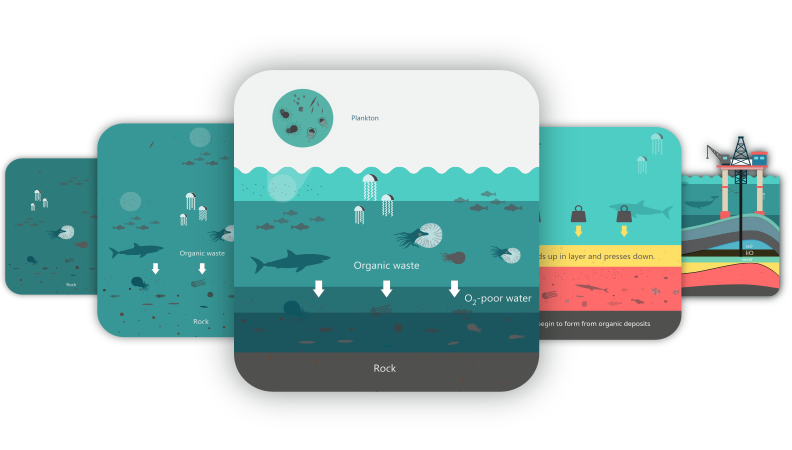When we build with ecobricks we plan for the end of the construction, for the next application of every ecobrick, and the next after that. This way we can be sure the cycles that result, enrich socially and ecologically.
One of the several core ecobricking principles is that of spiral design. Unlike linear and circular design, rather than plan in lines and circles, we plan in spirals. This way, we can embed an enriching spin of short and long-term reuse into the way we put our ecobricks to use.
Context
Everything comes to its end.
Today, the vast majority of the products we use go from their birth in a factory, into our hands, to their grave. Pollution is the result. Designs that fail to anticipate and plan for the end of a product are known as "cradle-to-grave".
Unfortunately, products and materials that are designed to be 'circular' also lead to pollution and ecological depletion. Although, "cradle-to-cradle" designs that can be used over are a step in the right direction, if the external impacts of each cycle aren't considered carefully (for example the making and fueling of the factory that makes a product), a spiral of depletion will result. Alas, we see this all too clearly with traditional industrial recycling: each time a piece of plastic is recycled, large amounts of emission-intensive transportation, sorting, smelting are required.
With ecobricks, we do things differently!
Guided by the principles of Earthen ethics, the cycles of ecobricks and their applications are designed to be ecologically enriching: greening. Not only do we plan for the next-life of our application, we also plan for its subsequent cycles.
To do so, we leverage the resilient properties of plastic to create reusable building blocks that have a procession of short and long-term applications. This means that we ensure that ecobricks are both indefinitely reusable and that each cycle of building and dissembly contributes socially and ecologically.
Following Earth's Example
Spiral design embodies the first principle of Earthen Ethics.
"Observe the way Earth tends its processes towards cycles that spiral."
For the last billion years, Earth has been slow and steady greening the surface of our common home.
The way that Earth has cycled and stored carbon has led to the blossoming of the biosphere– while providing us an example to follow to ensure their own processes are green! With our plastic– which happens to come from Earth's ancient carbon stores– we can emulate Earth’s example of ensuring that our processes and outputs are not only spiral, but that lead to ever enriching cycles.
Following Earth's example of carbon care is the basis of Earthen ethics– five principles of green based on our planet's cosmological character.
In the same way that Earth tends its carbon towards cycles of indefinite reuse, so too can we with our plastic. By packing our plastic into ecobricks and using our ecobricks properly, we can make sure our plastic can be used over and over indefinitely.
ℹ️ Learn about: The Long Story of Plastic
ℹ️ Learn about: Earthen Ethics
Making Ecobricks
Ecobricking and its application embody spiral design
Spiral design underlies every ecobrick method that the GEA endorses. This principle also helps guide the way that we make ecobricks and all the GEA's recommended best practices.
Some people wonder why, when we start an ecobrick we put a colored plastic on the bottom. Spiral design is why: we’re thinking of the ecobrick's next phase when we’ll build with it. This is also why we use cob or silicone when we attach ecobricks to make modules and not glue or cement. The first materials form a non-permanent bond, while the second are permanent. This way, when our creation comes to its end, we can take it apart and use the ecobricks again.

By leading by example in following Earth's example, our management of plastic can be a powerful inspiration for all our other materials and technologies.

Cycle Planning
From short-term cycles to long-term cycles
The Global Ecobrick Alliance advocates short and longterm cycle planning.
The first and simplest applications are short-term: such as ecobrick modules. These initial applications are ideal for first time ecobrickers as they only require a dozen ecobricks. However, using silicone, these applications enable full dissembly, reuse, and making of subsequent modules.
Once a household or community has numerous modules, they will also have sufficient ecobricks to build with earth. Once their modules come to an end, the ecobricks can be removed and used for building earthen gardens or benches.

Earthen constructions also enable full dissembly. However, because ecobricks will be dirty upon extrication, they lend themselves to further earth constructions: such as another garden planter or bench.

As communities accumulate more and more ecobricks, larger and more enduring structural constructions can be built. Eventually, as communities accumulate thousands of ecobricks, structural earth and ecobrick constructions can be made-- such as those using ecoJoiners to build geodesic domes and hex-lattice walls. These structures, though significantly more long-term, remain fully capable of being disassembled. Both the cob and the ecobricks (which have remained completely secured from degradation all the time they were inside the earthen construction) have the potential for reuse years or decades in the future.
Brickable Designator Icon
A clear expression of spiral intention and design
A symbol to set products on a spiral spin.
A practical extension of spiral design is the GEA’s work developing the Brickable Designator Kit. As ecobricks are essentially a catch-all for dead-end-plastic, they present an exciting and easy transitional solution for product designs.
Brickability allows designers to take their first step to spiral design. With a little forethought and advance planning, their product can be made easily and effectively Ecobrickable. This design direction allows the transition of a company to full regenerative principles (see our Catalyst company program).
Spiral vs Circular Design
It can be helpful to better understand what we mean by spiral design by clarifying what it is not. Ecobricking, for example, is often mistaken as a ‘sustainable’ or 'circular' technology. However, these terms refer to enabling our current human systems to spin indefinitely by minimizing their environmental harm. This is not the goal of ecobricking!
Rather than 'minimize harm' (and remain harmful), instead, with our ecobricks we aim at net ecological contribution. Instead of a static circle that spins indefinitely (no such thing exists!), we instead intend the way we use ecobricks toward cycles that enable richer societies and greener ecosystems.
Spiral design is inspired by the concept of Ayyew in the culture of the Igorot people of Northern Luzon. This Igorot concept inspired and guided the early Asian ecobrick movement, the work of the GEA and the development of our Earthen principles.
Learn about the indigenous wisdom tradition that underlies the Earthen ecobrick movement.
D'une Éthique Terrestre
Les écobriques sont basées sur les cinq principes de l'exemple terrestre
📗 Résumé
Résumé de l'éthique ⇗
Comptabilité écologique
La comptabilisation de nos impacts écologiques gris et verts est un élément clé de l'entreprise régénérative.
Le notre
Voyez notre comptabilisons
Entreprise pour la Terre
La GEA s'engage dans un modèle commercial à but non lucratif qui répartit tous les excédents financiers vers des bénéfices écologiques. Pour ce faire, nous divulguons nos impacts en matière de carbone, de plastique et de biodiversité et en veillant à ce qu'ils soient écologiques.
Notre exemple
Découvrez comment nous procédons.
Ver Le Concentration
Les applications Ecobrick suivent les principes de la conception Earthen pour intégrer le plastique dans des cycles spirale vers la concentration.
En savoir plus




